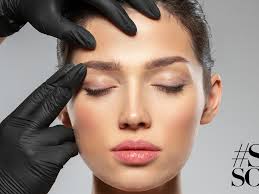
Which Wrinkle-Reducing Option Is Best for You? A Comprehensive Guide to Younger-Looking Skin
Your skin reveals much about your age, and wrinkles are among the most obvious indicators. They increase naturally over time, especially as your skin loses elasticity and firmness with age.
Wrinkles result primarily from the breakdown of collagen and elastin fibers. These vital components help keep your skin firm and supple during your younger years.
Dr. Patrick J. Byrne, a facial plastic surgeon at Cleveland Clinic, explains this process. He emphasizes that this breakdown is part of the natural aging cycle.
While genetics and skin type contribute to how early wrinkles appear, many lifestyle habits can speed up the process. Sun exposure, pollution, and smoking are key culprits.
One surprising factor in wrinkle development is your sleep position. Consistently sleeping on your face may cause lines to become etched in your skin.
A study published in Aesthetic Surgery Journal highlights how certain sleep habits may contribute to deeper facial creases over time.
For those looking to smooth out existing lines or prevent deeper ones from forming, injectables like Botox may be worth considering.
How Neurotoxins Like Botox Work to Reduce Wrinkles
Botox is a brand name for botulinum toxin type A. This injectable is derived from a bacteria known as Clostridium botulinum.
Though this bacterium causes the serious illness botulism, Botox injections are extremely safe when administered properly by professionals.
Dr. Byrne explains that botulinum toxin is a powerful neurotoxin. It targets the junction between nerves and muscles, blocking communication between them.
When injected, the toxin prevents targeted muscles from contracting. These relaxed muscles result in smoother skin above them.
Because muscle movement is reduced or stopped, expression lines become less visible. The effects usually last from two to six months.
Botox also works as a preventive tool. It may stop dynamic wrinkles from becoming permanent, particularly in high-movement areas of the face.
However, not all doctors agree on preventive use. Dr. Phillip R. Langsdon says he avoids treating patients who want Botox without having visible lines.
If you notice that certain facial lines remain even when you’re not making an expression, it may be time to consider a neurotoxin like Botox.
Beyond Botox: A Range of Injectable Options
Botox is the most recognized brand, but it’s far from your only choice. Alternatives include Dysport, Xeomin, Jeuveau, and Daxxify.
Each contains the same active ingredient—botulinum toxin A—but with different proteins or additives. These influence how each product spreads and lasts.
Dr. Byrne points out that while all neurotoxins work similarly, differences in formulation create subtle variations in how they perform in different patients.
Here’s a breakdown of these five options:
1. Botox (OnabotulinumtoxinA)
FDA Use: Approved for treating moderate to severe frown lines, forehead wrinkles, and crow’s feet.
Ideal For: Forehead lines, bunny lines on the nose, crow’s feet, and vertical lip lines. Botox is versatile and widely studied.
Pros: Well-researched, widely available, and reliable for a wide range of facial areas. Results typically appear in 3 to 7 days.
Cons: Some patients must wait one to two weeks for full results. Men often need higher doses due to stronger facial muscles.
Notes: Botox may not be suitable for patients with naturally low eyebrows. Treating forehead lines could cause further brow drooping.
2. Dysport (AbobotulinumtoxinA)
FDA Use: Approved for frown lines between the eyebrows. Offers faster onset of results in some cases.
Ideal For: People who want longer-lasting results and fewer appointments. May also benefit those with oily skin or enlarged pores.
Pros: Works quickly—results can be seen in two to three days. Effects may last up to five months for some patients.
Cons: It spreads more than Botox, so it may not be ideal for very small or specific areas. Precision may be slightly lower than Botox.
Notes: A 2021 study showed that Dysport reduces oiliness and acne. Some users experience fewer breakouts and tighter pores.
3. Xeomin (IncobotulinumtoxinA)
FDA Use: Treats moderate to severe frown lines between eyebrows.
Ideal For: Individuals who have developed resistance to Botox or Dysport. Xeomin is “naked,” with no complexing proteins.
Pros: Fewer additives may reduce the risk of building resistance. A good alternative if other injectables become ineffective.
Cons: Results appear more slowly—usually within 3 to 4 days, with maximum effect at 30 days. May wear off sooner than others.
Notes: Some users report that Xeomin lasts only two months. Still, it can be a valuable option for people needing a backup treatment.
4. Jeuveau (PrabotulinumtoxinA)
FDA Use: Approved for glabellar lines (the frown lines between your eyebrows).
Ideal For: Those open to trying newer options. Jeuveau is considered just as effective as Botox for forehead lines.
Pros: Same particle size and potency as Botox. May be preferred by some for personal or price reasons.
Cons: Less long-term data available compared to Botox and Dysport. Some doctors have less experience using it.
Notes: Patient feedback varies. Some believe it works faster or lasts longer, but results are largely personal preference.
5. Daxxify (DaxibotulinumtoxinA-lanm)
FDA Use: Approved for moderate to severe glabellar lines. It’s the longest-lasting option among neurotoxins.
Ideal For: Experienced patients who already know what to expect from injectables and want extended results.
Pros: May last six to nine months. Fewer appointments may reduce overall treatment costs and inconvenience.
Cons: If you’re unhappy with the results, you’ll have to wait longer for the effects to wear off compared to other injectables.
Notes: Daxxify is still new, so some dermatologists are cautious with first-time patients. Side effects are typically mild.
How Much Does It Cost?
According to the American Society of Plastic Surgeons, the average cost of an injectable treatment is around $466. Prices vary widely.
Factors that influence cost include the number of units used, the treatment area, the experience of the provider, and your location.
Daxxify may be priced higher than older neurotoxins due to its longer-lasting effects. Pricing may also change as it becomes more widely available.
Discuss expected costs during your consultation. Some offices offer discounts for repeat visits or multiple areas treated in a single session.
The Importance of Choosing a Qualified Provider
Regardless of the product, success depends on who’s administering it. Choose a board-certified plastic surgeon or dermatologist.
Experience matters. An improperly performed injection can cause drooping eyelids, uneven facial expressions, or more serious complications.
Never attempt to inject these products yourself. DIY botulinum toxin use is extremely dangerous and can lead to permanent nerve or muscle damage.
A 2018 study in Plastic Surgery warned about the rising popularity of self-injection tutorials online. These can result in serious and permanent harm.
According to the American Academy of Dermatology Association, possible side effects from improper injections include facial paralysis and vision issues.
Always confirm your provider’s credentials. Use resources like CertificationMatters.org to verify board certification.
Before Your Appointment: What to Expect
Your first step will be a consultation. This discussion will cover your goals, medical history, and current medications.
Your provider may ask about any past procedures, allergies, and whether you’re pregnant or planning to become pregnant.
Use the consultation to ask questions. Ask how many procedures the provider has performed, what products they use, and their success rates.
Make sure to discuss any alternative treatments that might be more appropriate. Your provider might suggest a combination of approaches.
Final Thoughts: Finding the Right Wrinkle-Reducer for You
Injectables can significantly improve the appearance of fine lines and wrinkles. Choosing the right one depends on your goals, budget, and preferences.
Each neurotoxin offers unique benefits. Botox is a tried-and-true option. Dysport spreads more and may last longer. Xeomin is great for sensitive users.
Jeuveau is newer but comparable to Botox. Daxxify offers long-lasting results but is better for those familiar with wrinkle treatments.
No matter which you choose, safety should be your top priority. Work with qualified professionals and avoid shortcuts to protect your health and appearance.


